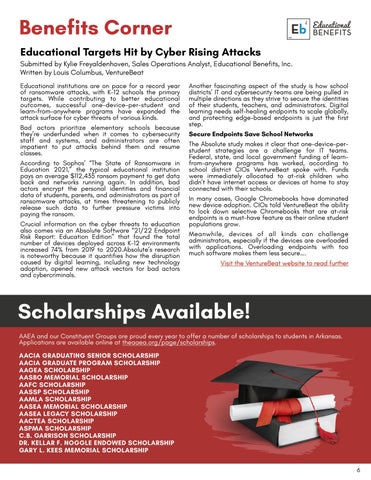Benefits Corner Educational Targets Hit by Cyber Rising Attacks Submitted by Kylie Freyaldenhoven, Sales Operations Analyst, Educational Benefits, Inc. Written by Louis Columbus, VentureBeat Educational institutions are on pace for a record year of ransomware attacks, with K-12 schools the primary targets. While contributing to better educational outcomes, successful one-device-per-student and learn-from-anywhere programs have expanded the attack surface for cyber threats of various kinds. Bad actors prioritize elementary schools because they’re underfunded when it comes to cybersecurity staff and systems, and administrators are often impatient to put attacks behind them and resume classes. According to Sophos’ “The State of Ransomware in Education 2021,” the typical educational institution pays an average $112,435 ransom payment to get data back and networks running again. In addition, bad actors encrypt the personal identities and financial data of students, parents, and administrators as part of ransomware attacks, at times threatening to publicly release such data to further pressure victims into paying the ransom. Crucial information on the cyber threats to education also comes via an Absolute Software “21/22 Endpoint Risk Report: Education Edition” that found the total number of devices deployed across K-12 environments increased 74% from 2019 to 2020.Absolute’s research is noteworthy because it quantifies how the disruption caused by digital learning, including new technology adoption, opened new attack vectors for bad actors and cybercriminals.
Another fascinating aspect of the study is how school districts’ IT and cybersecurity teams are being pulled in multiple directions as they strive to secure the identities of their students, teachers, and administrators. Digital learning needs self-healing endpoints to scale globally, and protecting edge-based endpoints is just the first step. Secure Endpoints Save School Networks The Absolute study makes it clear that one-device-perstudent strategies are a challenge for IT teams. Federal, state, and local government funding of learnfrom-anywhere programs has worked, according to school district CIOs VentureBeat spoke with. Funds were immediately allocated to at-risk children who didn’t have internet access or devices at home to stay connected with their schools. In many cases, Google Chromebooks have dominated new device adoption. CIOs told VentureBeat the ability to lock down selective Chromebooks that are at-risk endpoints is a must-have feature as their online student populations grow. Meanwhile, devices of all kinds can challenge administrators, especially if the devices are overloaded with applications. Overloading endpoints with too much software makes them less secure…. Visit the VentureBeat website to read further
Scholarships Available! AAEA and our Constituent Groups are proud every year to offer a number of scholarships to students in Arkansas. Applications are available online at theaaea.org/page/scholarships. AACIA GRADUATING SENIOR SCHOLARSHIP AACIA GRADUATE PROGRAM SCHOLARSHIP AAGEA SCHOLARSHIP AASBO MEMORIAL SCHOLARSHIP AAFC SCHOLARSHIP AASSP SCHOLARSHIP AAMLA SCHOLARSHIP AASEA MEMORIAL SCHOLARSHIP AASEA LEGACY SCHOLARSHIP AACTEA SCHOLARSHIP ASPMA SCHOLARSHIP C.B. GARRISON SCHOLARSHIP DR. KELLAR F. NOGGLE ENDOWED SCHOLARSHIP GARY L. KEES MEMORIAL SCHOLARSHIP 6







